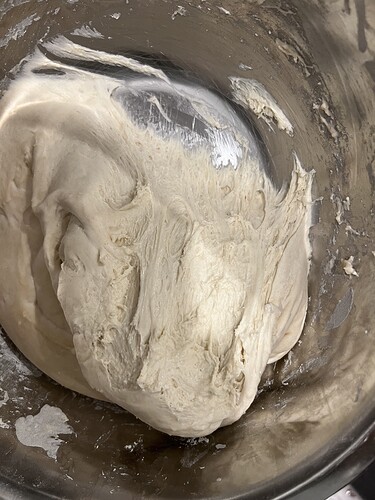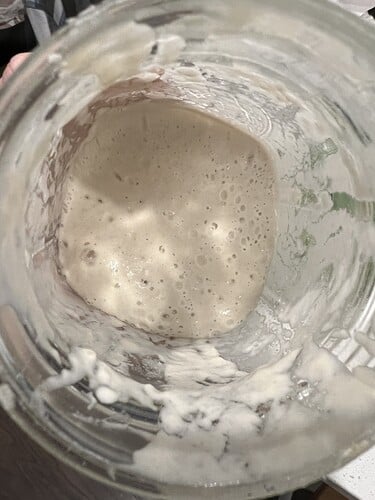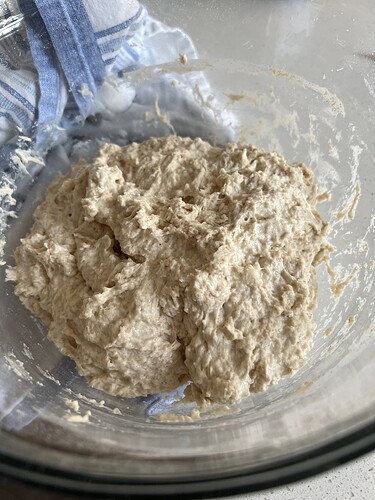I have made SEVERAL loafs of bread over the last year and I continue to have the same issue every time. Really needing help! I’m just trying to make a typical white bread for sandwiches, but every time they come out DENSE and almost like the didn’t rise correctly the second rise. I am using a standard bread recipe from the Kitchen Aid recipe book. The first rise is wonderful! I mix all ingredients according to recipe and basically follow it, allowing more or less mixing time depending on the status of the dough. Once I have that good silky yet stretchy window pain type dough I put it in a greased bowl and allow the first rise which typically takes about an hour to double in size or more. I then “punch down” the dough gently and divide to two loafs and add them to the greased bread pans. I am using a 9x5 pan. The second rise usually stalls or stops completely about the time the top of the loaf is even with the top of the pan. From this point if I allow it more time it will typically fall or just stop rising. So that is the point where I bake it. But it always comes out “flatter” or less tall than id like and DENSE. Please any advice on how to keep my bread from being so dense would be wonderful!
THANKS!!!
You need to bake sooner. On it’s way up not when it has stopped or it’s on its way down. Fill each pan to two thirds full then bake when the dough just crests the top of the pan.
Basically your dough is over proofed. For oven spring there needs to be strength left in the dough. Once it has over proofed there won’t be much oven spring if any at all. Once a yeasted dough has doubled then final proofing should be quite quick at 40 minutes to 1 hour depending. By filling the loaf pan by 2/3rds you’ll get a good visual of when it bake.
I dont have enough dough to fill the pans 2/3. I can get 1/3 in each pan. My total flour used each time is apx 5 cups. Are my two 9x5 pans just that much too big? Should I just make one loaf? Or could I possibly be letting my first rise go too long?
If you are filling two pans by 1/3rd and aiming for the dough to crest the top then you’re waiting too long before baking.
Either double the recipe and fill each pan by 2/3rds. Or make one loaf filling one pan by 2/3rds.
Doubling for the first rise with a yeasted bread flour dough is fine. But have in mind the second rise shouldn’t really take longer than 40 minutes - 1 hour depending.
Firstly try filling the pan, or pans, by 2/3rds and baking sooner. But you should find if you do fill the pans correctly then the dough will be cresting the top ready to bake within that time frame.
May I suggest, just until you get it right, to try making the same recipe but using one pan. If it all goes fine and you wish to make two loaves then double up.
I will definitely be doing just that. I only let the second proof go about 40 minutes to one hour max. So if I shorten my first proof could that allow my second proof to be more efficient as the yeast would still have more “food” available and possibly give better rise? Also, how much oven spring should I possibly be experiencing? As it stands I get nearly no spring in the oven. Thank you so much for the advice and help!
Usually bread flour yeasted doughs are perfectly fine to double and then final proof for 40 minutes to 1 hour. There should still be plenty of food left. Unless what you think is doubling is actually more. What is your recipe and how do you measure doubled?
Certainly filling a loaf pan by 1/3rd and expecting it to crest the top is too much because that will be more than tripling for the second rise. So whatever the case the recipe you’re doing now is for one pan.
If done right you should get a good oven spring and should rise quite a bit in the oven. What you can do, for an experiment, would be to wait until the first proof looks aerated and puffy and even if it hasn’t quite doubled then go ahead and shape. Can’t go wrong.
I just bought a starter from breadtopia a little over a week ago. I fed my starter and made my first loaf within 2 days. It was dense and didn’t rise much in the bulk fermentation. I did some research and felt like I needed to bulk up my starter. I originally used All purpose flour for the first loaf but decided to switch to bread flour. I fed it twice with bread flour before using it again to bake. It seems to be stronger but my bread didn’t rise again much during bulk fermentation. I could see some bubbles on the sides and it felt fluffier than the first loaf. Do I just need to give it more time? Should I leave it out and feed it small amounts over the next week to help the starter build More?
What is your starter feed ratio, how much does it bubble up, how long does it take and when do you use it?
A lot more info is needed.
Yesterday night, I fed it 100g water and 100g bread flour. I let it sit on the counter overnight for 8-9 hours. It doubled and I pulled out 50g and added it to 350 grams of water to start my dough.
Then I added 500g of bread flour and 10g salt. Mixed and let it sit for an hour before doing 3 stretch and folds, 30-40 minutes apart. Then I left it sit for 7 hours and didn’t see it rise much.
50g starter to 500g flour is 10% starter. You should see some rise but depending on your starter and temperature of the dough it could take longer.
From the sound of things your starter does rise so it should work. How about next time…
- 500g flour (450g bread flour + 50g whole wheat flour)
- 350g water
- 10g salt
- 100g active starter
Nothing fancy for now. Start in the morning. Form the dough and knead till full gluten formation. Don’t shape till the dough has doubled. Keep it warm. Aim for 75F.
If the dough fails to rise and it’s been 6-8 hours. Then something is wrong. Do not throw the dough away. It can be saved by dissolving some yeast in a little warm water then kneading it into the dough. Then carry on as a yeasted dough.
Take photos of each stage and let us know how it goes.
Ok, I will try those ratios.
My house is usually about 68F. How can I keep it at 75F?
This and only 10% starter will explain a lot. It’ll still work at 68F but expect it to take longer. Watch the dough and not the clock. If you start the dough early in the day then you should have plenty of time.
A healthy starter is a collection of competing bacteria colonies complimented by competing fungus colonies, forming a balanced microbiome. Change anything about the environment, the substrate or the hydration of the microbiome and the delicate balance is lost. If the microbiome is only a little out of balance you may not notice it, a lot out of balance it can go completely flat, or anything in between.
When you purchase a starter you are getting a microbiome. You do not get a supporting supply of the substrate (wheat) or the hydration (water) used to create that microbiome. Your wheat, your water, will throw the whole thing out of balance. Realistically, it is reasonable to expect the initial performance of the starter to be less than stellar. Over time the microbiome will be adjusting to create a new balance within the hydration and substrate you provide, becoming stronger, and more so if you do not change the water source or the wheat you are providing the microbiome.
I suggest you stick with the same flour and water source, and keep the starter on the counter, until you have revived it into a robust starter, again. It may in as little as a couple feedings, or it may take a week or more. Then, if you want to change the wheat you use for the starter, do it over 5 feeding, swapping out only 20% of the wheat at a time. If you have a robust starter when you begin to change the wheat, you still will be able to use the starter to make bread as you are going through the wheat change-over. It works the same with the water source.
Back at it on my day off! I fed my starter overnight and it doubled so I made my dough with your recommendations!
I also figured out that my oven light produces some heat! So I have it on and I am going to try rising it in there to see if it helps!
Good idea. How’s it going?



